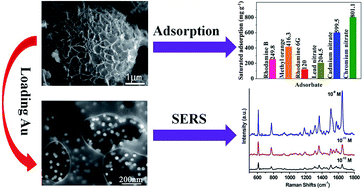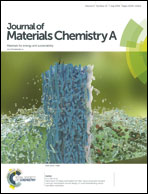Hierarchical porous carbon microspheres with superhydrophilic surface for efficient adsorption and detection of water-soluble contaminants†
Abstract
Generally, due to the disappearance of hydrophilic groups, graphene-based materials produced by high temperature pyrolysis or reduction are hydrophobic and can be used to separate oil-soluble compounds, which limits their application in water-soluble systems. Herein, we report hierarchical porous N-doped carbon microspheres (NCMSs) with superhydrophilic surfaces (contact angle is zero) for efficient adsorption and detection of water-soluble contaminants. These NCMSs are synthesized from pomelo peel at large scale and low cost and have an ultralarge surface area (2850.4 m2 g−1), ultrahigh pore volume (1.85 cm3 g−1), ultralight density (0.46 mg cm−3), and high conductivity (5 × 102 S m−1). Unlike usual graphene materials, these NCMSs have a superhydrophilic surface due to the N-heteroatom induced polarity enhancement. As a superhydrophilic adsorbent, its adsorption capacities for Rhodamine B, methyl orange, Rhodamine 6G, Pb2+, Cd2+, and Cr3+ are up to 249.8, 416.3, 120, 204.5, 599.5, and 801.1 mg g−1, respectively. Furthermore, by combining the ultrastrong adsorption and isolation effect of porous graphene sheets and the plasmon resonance effect of Au nanoparticles, the assembled Au/NCMSs can be used as an active surface-enhanced Raman spectroscopy (SERS) substrate with an outstanding enhanced factor (EF) of 3.6 × 1010 and an ultralow detection limit of 10−13 M for organic molecules.



 Please wait while we load your content...
Please wait while we load your content...